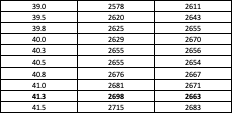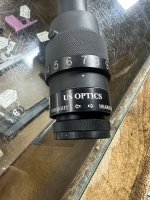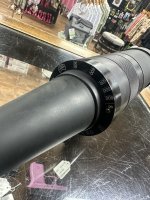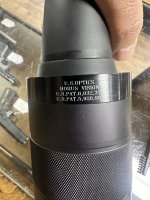Join the Hide community
Get access to live stream, lessons, the post exchange, and chat with other snipers.
Register
Download Gravity Ballistics
Get help to accurately calculate and scope your sniper rifle using real shooting data.

Install the app
How to install the app on iOS
Follow along with the video below to see how to install our site as a web app on your home screen.
Note: This feature may not be available in some browsers.
You are using an out of date browser. It may not display this or other websites correctly.
You should upgrade or use an alternative browser.
You should upgrade or use an alternative browser.
Latest activity
Filter
Filters
Show only:
Scope identitification needed.. info please
- By sniper307
- Observation & Sighting Devices
- 5 Replies
Forgot to add that it is a 3.8x22x58 mm
PortaJohn
- By mosin46
- The Bear Pit
- 158579 Replies
Putin would have had the sense to shoot him,Clinton and a whole bunch more people. treason is not appreciated in Russia. China either i don't think. we have put up it with since at least 1946 and treason from the ruling class longer.
Get ready for the Cartels to step up their game,...
- By lariat
- The Bear Pit
- 98 Replies
If Seattle and Cali are any guide, no one. Tent cities and crime everywhere.So who’s going to deal it’s all the psychos?
Guys!! I found Lucky Duck!!
- By LeftyJason
- The Bear Pit
- 78 Replies
They used to all be stacked on top of the d and o and were the same color (blue) as the rest of the name.View attachment 8744244
Some thing is glitched out, I keep seeing these symbols through your handle.
Maggie’s Funny & awesome pics, vids and memes thread (work safe, no nudity)
- By Lawless
- The Bear Pit
- 118302 Replies
Gotta hand it to the female cop, she ain’t skeered…..she ain’t trained….but she ain’t skeered.
Login to view embedded media
Login to view embedded media
Maggie’s Funny & awesome pics, vids and memes thread (work safe, no nudity)
- By Modoc
- The Bear Pit
- 118302 Replies
Another take on a classic

AR15 magazine recommendations
- By dms416
- Semi-Automatic Rifles
- 16 Replies
Are you legally bound to 10? I've seen things get weird with 8,9, 10 rounders due to the shorter spring and follower situation. I don't go lower than 20 if I don't have to.
If I'm shooting for groups, I always roll with a newer Gen 3 PMag. Colt/NHMTG/OKAY/Surefeed are my go to for non polymer.
The problem with most AR mags is folks keep em in use WAAAY to damn long. The beauty of a PMAG is their failure point...unlike the others where lip spread can be way too much, causing problems and you don't know it.
If I'm shooting for groups, I always roll with a newer Gen 3 PMag. Colt/NHMTG/OKAY/Surefeed are my go to for non polymer.
The problem with most AR mags is folks keep em in use WAAAY to damn long. The beauty of a PMAG is their failure point...unlike the others where lip spread can be way too much, causing problems and you don't know it.
Get ready for the Cartels to step up their game,...
- The Bear Pit
- 98 Replies
Always go after the leadership. Always.
Have i changed a single mind? Pi**a G@te IS real!
- The Bear Pit
- 867 Replies
If this is not disgusting beyond words...
Fucking world bank... as bad as USAID for loading up the leftist coffers. Abusing 7 and 8 year old girls and boys... Hope he never sees his home country again... Raped to Death in federal Pen would be most excellent.

 www.breitbart.com
www.breitbart.com
Sirhr
Fucking world bank... as bad as USAID for loading up the leftist coffers. Abusing 7 and 8 year old girls and boys... Hope he never sees his home country again... Raped to Death in federal Pen would be most excellent.

Former D.C. Diplomat Charged with Sexually Abusing His Children's Playmates
A World Bank consultant and former Australian diplomat has been charged with sexually abusing three of his children's playmates who lived in his Northwest Washington, DC, neighborhood.
Sirhr
AR15 magazine recommendations
- By Roslyn
- Semi-Automatic Rifles
- 16 Replies
I am interested in trying some 10 round magazines from manufacturers other than Magpul. They'll be running in Compass Lake lowers, if that makes any difference. Have had some trouble with Pmags recently (irregular feed lips) and would like to see what other options experienced shooters consider reliable. Metal, polymer, or mix, I have no biases about who makes them or how.
Appreciate any suggestions.
Appreciate any suggestions.
6.5 Creedmoor
- By Renomd
- Reloading Depot
- 4481 Replies
Hoping this helps someone for heavy bullets, there is some info out there but not a lot on the Berger 156 gr EOL in 6.5 creedmoor. Goal is to make power factor (which it does easily).
Powder: H4350
Brass: Lapua virgin SRP
Primer: CCI450
Platforms: 1) Accuracy international AX308 MC M27 Short action 24" Bartlein 8 twist by the one and only Robert Graduous 500 rounds on it prior to load workup SRS Ti Pro 4 muzzle brake 2) Impact NBK w/ a proof Lone Peak prefit carbon 24" 8 twist 1350 rounds on it before load development (headspace perfectly and fired dimensions are near identical to all of my other 6.5 CM barrels I've owned) MDT CRBN stock, TMB tuner brake 6.5mm.
Ladder, seated 0.02" jump on the AIAX, 0.045" on the proof Impact/LP (which is 2.945 COAL for both) b/c of throat erosion likely

What is crazy is the AIAX ladder shots were touching into the same hole but was .5" wide, I couldn't believe it given the velocity dispersion but demonstrates the accuracy of the AI platform, and how you can't rely just on group size at 100yd for long range consistency. I did not have any pressure signs on this test, 75 degrees at 4500 ft elevation.
AIAX: 41gr initially had the best group and SD/ES 2680 fps average, SD 5, ES 9, 3 shot group .211 MOA ; but, after going out for a seating depth test 41gr was much hotter and had heavy bolt lift at 2730 fps, so pulled the remainder of the rounds and backed it down to 40gr and one load at 39.5gr which all absolutely hammered! Bore scope did NOT reveal any carbon rings in neck of the chamber or in front of the lands. SD and ES on 40gr weren't the best however.... 39.5 though is great at 0.190 MOA seated .02" off the lands.


Impact NBK LP (lone peak) proof factory prefit carbon 24" 8 twist: Went w/ 40gr based on ladder satterlee test, w/ exception of 2 outliers the SD and ES's of this 40gr charge was great at 2603 fps average. Accuracy was pretty solid too seated at 0.045" 0.306 MOA, and .075" off lands at .203 MOA, using the TMB tuner brake at 0 setting. What worries me is the migrating 3 shot group could have been the nightforce NX8 4-32 but I had dialed out ALL of the parallax, hopefully its not the MDT CRBN stock which is not bedded but installed the impact correctly. I had a .03" seating depth off the lands that opened up to .643 MOA but I think this was me b/c I'm not used to shooting a fairy light gun.


As always workup slow and use this info at your risk. Everyone's powder lot is different and I'm shooting at 4500 ft elevation.
Powder: H4350
Brass: Lapua virgin SRP
Primer: CCI450
Platforms: 1) Accuracy international AX308 MC M27 Short action 24" Bartlein 8 twist by the one and only Robert Graduous 500 rounds on it prior to load workup SRS Ti Pro 4 muzzle brake 2) Impact NBK w/ a proof Lone Peak prefit carbon 24" 8 twist 1350 rounds on it before load development (headspace perfectly and fired dimensions are near identical to all of my other 6.5 CM barrels I've owned) MDT CRBN stock, TMB tuner brake 6.5mm.
Ladder, seated 0.02" jump on the AIAX, 0.045" on the proof Impact/LP (which is 2.945 COAL for both) b/c of throat erosion likely
What is crazy is the AIAX ladder shots were touching into the same hole but was .5" wide, I couldn't believe it given the velocity dispersion but demonstrates the accuracy of the AI platform, and how you can't rely just on group size at 100yd for long range consistency. I did not have any pressure signs on this test, 75 degrees at 4500 ft elevation.
AIAX: 41gr initially had the best group and SD/ES 2680 fps average, SD 5, ES 9, 3 shot group .211 MOA ; but, after going out for a seating depth test 41gr was much hotter and had heavy bolt lift at 2730 fps, so pulled the remainder of the rounds and backed it down to 40gr and one load at 39.5gr which all absolutely hammered! Bore scope did NOT reveal any carbon rings in neck of the chamber or in front of the lands. SD and ES on 40gr weren't the best however.... 39.5 though is great at 0.190 MOA seated .02" off the lands.
Impact NBK LP (lone peak) proof factory prefit carbon 24" 8 twist: Went w/ 40gr based on ladder satterlee test, w/ exception of 2 outliers the SD and ES's of this 40gr charge was great at 2603 fps average. Accuracy was pretty solid too seated at 0.045" 0.306 MOA, and .075" off lands at .203 MOA, using the TMB tuner brake at 0 setting. What worries me is the migrating 3 shot group could have been the nightforce NX8 4-32 but I had dialed out ALL of the parallax, hopefully its not the MDT CRBN stock which is not bedded but installed the impact correctly. I had a .03" seating depth off the lands that opened up to .643 MOA but I think this was me b/c I'm not used to shooting a fairy light gun.
As always workup slow and use this info at your risk. Everyone's powder lot is different and I'm shooting at 4500 ft elevation.
Attachments
Saw this on the book of face
- By Rthur
- The Bear Pit
- 14 Replies
Don't clock a vent at 12:00.
Might need a follow up shot.
R
Might need a follow up shot.
R
Night Vision DNT Hydra HS635
- By cdholmes
- Observation & Sighting Devices
- 48 Replies
I think if you’re going dedicated the LRF will be kinda essential
I forgot to mention, I would be running as a clip on. If I get the DNT, I'd probably run it dedicated on one rifle and clip on on another.
So internment camps for anti-vaxers are still on
- By TheHorta
- The Bear Pit
- 26 Replies
The shooter WAS Vaxxed. He’s hardly an “anti-vaxxer.”
Accessories SOLD....... ACE Muzzle Brake .30 cal.
- By Thumper580
- Buy - Sell - Trade
- 2 Replies
SOLD......
Get ready for the Cartels to step up their game,...
- By TheHorta
- The Bear Pit
- 98 Replies
Legalize / Decriminalize all drugs. Domestic production only.
Ending demand eliminates supply.
Ending demand eliminates supply.
Accuracy International Picture Thread
- By Bacarrat
- Bolt Action Rifles
- 23984 Replies
I have seen more then one 300 PRC have the same issue with factory ammo. I have read somewhere long time ago 300 PRC not liking it with higher pressure, depends on the chamber. Doesnt help that it's Hornady ammo. They are notorious for having shit brass.
Scope identitification needed.. info please
- By sniper307
- Observation & Sighting Devices
- 5 Replies
I recently acquired this in a collection that I bought. Amongst the collection was a new unfired Barrett M82 from 2004. The seller stated that he had an optic to go with it and presented me with this. I know it is a US optics and I believe that it is the SN 3 model. The scope does not look to ever have been mounted and it does have a Horus vision reticle. I believe to be H 27 or a variant of such. All of the SN 3 models that I see typically have a larger elevation knob( Erek) . This one has capped turrets that appear to be MIL based where is everything I see in literature showed MOA , can someone shed me a little info on this? Anyone have an idea what it’s worth? Us Optics is calling me back Monday with a little data, but I figured u guys would know .
Attachments
6 ARC Upper Build: 18” PVA Osprey (Rifle +2”) + San Tan Tactical Billet Upper + SOLGW M89 Rail
- By black5.3
- Semi-Automatic Rifles
- 81 Replies
Interested to see what @bohem says about the issue.
Load more









